TL;DR
- 2025 AI chat-to-app tools can turn prompts, voice, or screenshots into deployable apps in hours.
- Speed is real, but code ownership, scalability, and maintainability decide long-term value.
- Compare platforms: AppWizzy, Lovable, Bolt.new, Replit, v0.dev, Debuild, Cursor, Dust.tt, Pythagora.
- Choose based on exportability, CI/CD, cost, and team fit; AppWizzy targets investor-ready, full-stack builds.
Fact Box
- GitHub’s 2024 research: AI-assisted devs complete boilerplate and repetitive tasks 55% faster.
- McKinsey estimates missing the generative-AI wave could forgo up to $4.4T in productivity gains by 2030.
- Lovable recently raised $15M in funding, signaling traction for chat-driven app building.
- AppWizzy generates full stack (frontend, backend, DB, CI/CD, Docker) with exportable, self-hostable code.
- v0.dev turns text prompts into React components styled with Tailwind and deployable to Vercel.
Stick around till the end – you’ll learn which new AI platforms can save you six months of dev time (and six figures of runway) before you write a single line of code.
When you Google “AI chat app builder” or “AI web app generator,” you’re likely asking yourself:
- Can I really build a working app just by chatting with AI?
- Will that code actually scale, or will it break once users arrive?
- Is the output clean enough for investors, compliance, and engineers to trust?
- And how do I avoid vendor lock-in when my startup finally takes off?
As Satya Nadella famously said, “Every company is now a software company.” In 2025, that’s no longer hyperbole – it’s survival.
The numbers are staggering.GitHub’s 2024 research showed that AI-assisted developers complete boilerplate and repetitive tasks 55% faster. McKinsey estimates that missing the generative-AI wave could cost companies up to $4.4 trillion in productivity gains by 2030. But speed without structure is a trap: the wrong tool can turn a promising MVP into a rewrite nightmare six months later.
We’ve spent more than 15 years in software development and over a decade leading Flatlogic, where we’ve built production-grade software for startups and enterprises worldwide – CRMs, ERPs, SaaS platforms, you name it. Our latest product, AppWizzy, merges that real-world engineering discipline with cutting-edge AI – a professional vibe-coding platform that turns plain English (or even screenshots and voice notes) into working, deployable web applications.
So this list isn’t theoretical. It’s written by someone who’s tested, compared, and deployed these systems in real startup environments. By reading this article, you’ll understand:
- The difference between chat-to-code and chat-to-app systems.
- Which AI builders prioritize speed versus maintainability?
- Where tools like Lovable, Bolt.new, Replit, and AppWizzy truly fit.
- And how to choose a platform that won’t collapse during investor due diligence or customer growth.

Terminology / Definitions
| Term | Definition |
| Chat-to-App Builder | An AI system that builds functional web or mobile apps directly from natural-language input. |
| Prompt-to-Production | The process of turning plain English prompts into runnable, deployable applications. |
| AI Agentic Builder | A new class of AI that not only generates code but tests, deploys, and maintains it autonomously. |
| MVP (Minimum Viable Product) | The first functional version of a product that allows real-world testing and user feedback. |
| CI/CD (Continuous Integration / Continuous Deployment) | Automated pipelines ensure every code change can be safely tested and deployed. |
The AI App-Building Landscape in 2025
In 2025, we’re no longer simply talking about AI development tools – we’re living through the shift. The baseline has moved: it’s no longer a question of “Can AI help build apps?” but rather “Which AI builder will shape our stack for the next five years?”

What’s changed and what’s driving it
Several forces are converging right now:
- AI + Low‑code/No‑code convergence: According to a recent survey, 76 % of tech leaders believe AI will make low‑code tools much more efficient.
- Multimodal intelligence and agentic tooling: Systems are increasingly handling text, image, audio, and video simultaneously – enabling richer app‑builder input (e.g., voice + screenshot to “build this”).
- Democratization of app creation: The barrier to “build something live” is dropping. More non‑technical founders are deploying apps in hours, not months.
- Migration risk and ownership awareness: As more founders build quickly with AI, the “what happens at scale?” question looms larger. Platforms that lock you in or produce brittle code will cost you.
What it means for founders and product teams
For you – building SaaS, CRMs, ERPs, internal tools, or side‑projects – this environment presents both opportunity and risk:
- Opportunity: Speed is real. You can go from concept → working prototype in days, maybe even hours. That means lower runway burn, faster investor proofs, quicker feedback loops.
- Risk: If you pick a tool built only for “demo speed,” you might hit the ceiling: You’ll still need to rewrite large parts of the system when real users arrive, the stack needs to scale, or audit/compliance pressures come in.
- Strategic inflection: This isn’t just about making an app. It’s about choosing the shape of your codebase, team, and growth path. The platform you pick influences who you hire, how you deploy, how you maintain, and how you exit.
Key dimensions to watch in 2025
When you evaluate AI app‑builders this year, don’t just ask “can it generate something fast?” Ask how it handles:
- Ownership & exportability (can you own the code, self‑host, migrate?)
- Code quality and maintainability (typed ORMs, clear schema, CI/CD pipelines)
- Real‑world scalability (does the stack hold up under real traffic, feature growth, regulation?)
- Usability for both non‑tech and tech team members (can non‑coders iterate, can engineers refine?)
- Business alignment (pricing, hidden token costs, vendor lock‑in risk)
Why this matters more than ever
Because the myth of “build fast and rewrite later” is shrinking. Every month you spend rewriting, you burn runway, lose momentum, and risk investor confidence. The hidden cost of choosing the wrong platform isn’t just technical debt – it’s strategic debt. As one trend article put it: “Generative AI is no longer a luxury – it’s becoming the backbone of modern application development.”
TL;TR Top 10+ AI Chat-to-App Builders in 2025
| Platform | Core Identity | Users | Pricing Model |
| AppWizzy (by Flatlogic) | Professional vibe-coding platform – AI builds, edits, and deploys real SaaS apps inside live dev environments. | Founders and teams needing investor-ready MVPs and full control. | Credit-based “pay-as-you-build.” |
| Lovable | Chat-driven MVP builder for non-technical founders. | Solopreneurs, early-stage founders. | Freemium → $20-30/mo. |
| Bolt.new | Browser-based IDE with an AI pair-programmer. | Developers who want speed with full transparency. | Token-metered usage. |
| Replit (Ghostwriter) | Full cloud IDE with multi-language support and AI autocomplete. | Technical teams, educators. | Free core, $10-20/mo for Ghostwriter. |
| v0.dev (by Vercel) | Generates UI from text prompts, instantly deployable to Vercel. | Frontend developers, designers. | Free, with Pro tiers. |
| Debuild | Fast web app scaffolding from simple prompts. | Makers, indie hackers. | Freemium. |
| Cursor | AI-native code editor with multi-agent collaboration. | Developers are integrating AI directly into the workflow. | Freemium / Pro. |
| Dust.tt | Focused on AI workflows and API integrations. | Technical founders building AI products. | Usage-based. |
| Pythagora | Open-source backend generator from API requests. | Engineers want transparent AI generation. | Free, open-source. |
Top 10+ AI Chat-to-App Builders in 2025
In 2025, we’re witnessing the rise of AI‑as‑a‑Software‑Engineer – systems that translate plain English (or even screenshots and voice) directly into real, deployable web applications. From hobbyists to enterprise teams, founders now choose between dozens of “chat‑to‑app” tools that promise speed, ownership, or production‑readiness in different proportions.
Below are the most influential platforms shaping the new software‑development landscape – each with its own balance of speed, structure, and scalability.
AppWizzy
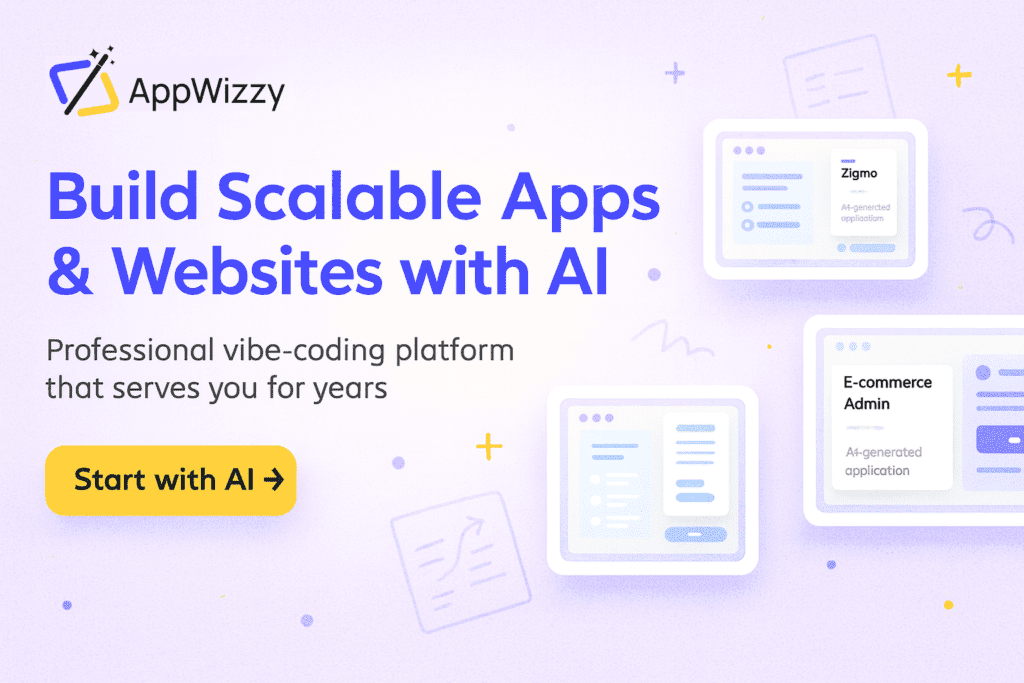
AppWizzy bills itself as a “professional vibe‑coding platform” that takes natural language (plain English, voice, or screenshot) and spins up deployable web apps you can own and iterate. It generates the full stack (frontend + backend + database + CI/CD + Docker), and allows export/self‑hosting or keeping on its runtime. It’s built by the team behind Flatlogic, drawing on their decade of production‑grade business‑software experience.
Target Audience: Founders or startups building serious SaaS/CRM/ERP systems (not just demos), who want to move fast but still deliver investor‑ready architecture.
Key Features: Full-stack generation + deployable container, typed ORM & modular architecture, chat/voice prompt interface, exportability and ownership of codebase, infrastructure‑agnostic deployment.
Pricing: Credit‑based “pay‑as‑you‑build” model (AI token credits + hosting + template license) per their site.
Lovable
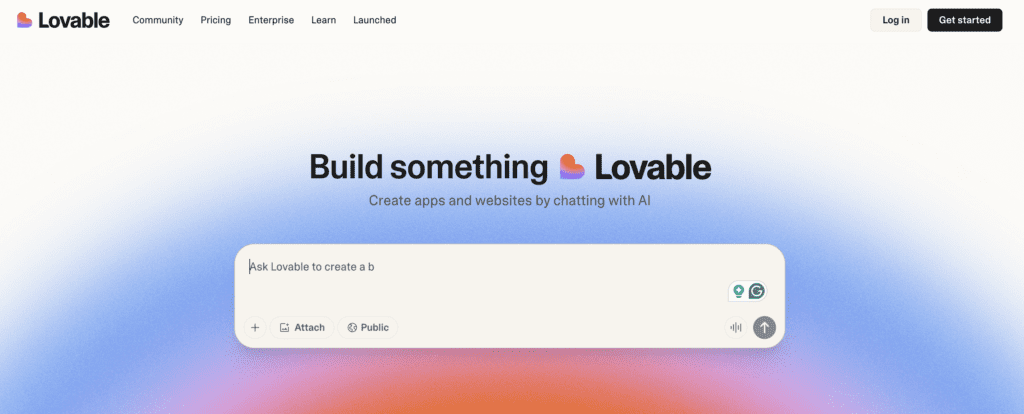
Lovable allows users (even non‑developers) to build full‑stack web apps by chatting with the AI – describing what they want (“dashboard with login, chart, Stripe payments…”) and watching it appear. It uses Supabase and has GitHub integration, making it a legit no‑code+generation hybrid. Recently, it raised significant funding ($15M), signalling serious traction.
Target Audience: Solopreneurs, designers, and non‑technical founders who want to validate ideas fast and build something usable without a deep dev team.
Key Features: Chat‑based UI, one‑click deploy, backend + frontend generation, exportable code, templates for typical SaaS/dashboard apps.
Pitfalls: Code quality and scalability may hit limits (for instance, when you need complex multi‑tenancy, heavy integrations, or compliance); some reports suggest the platform is used heavily for demos and may require “cleanup” later.
Pricing: Freemium start; typical actively used hosted MVPs are around ~$20‑$30/month. (Exact tiers vary)
Bolt.new
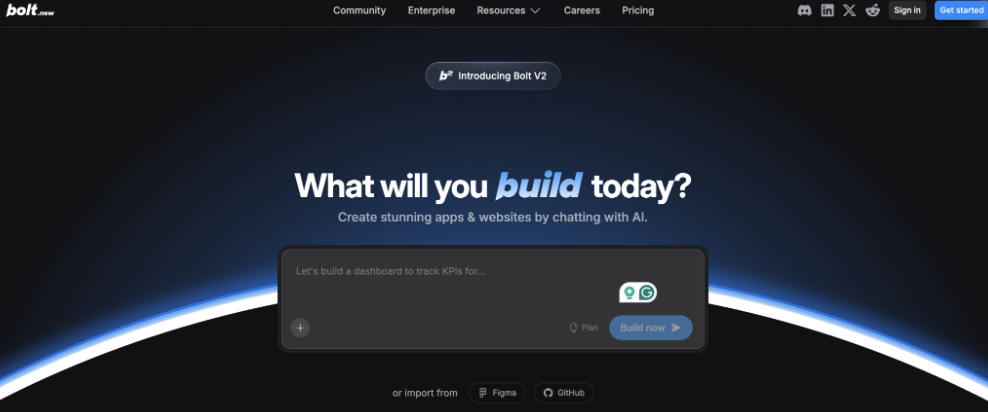
Bolt.new – built by the team at StackBlitz – is a browser‑based full IDE + AI pair‑programmer experience. You pick a stack (Next.js, Vue, Go, etc), describe features (“Add OAuth GitHub, real‑time chat”), and the AI scaffolds the project live; you can then edit in‑browser, deploy, and export.
Target Audience: Developers and engineering teams who want speed but still maintain deep control of code, files, configs, and stack.
Key Features: Real‑time browser editor + terminal, prompt‑based project generation, stack choice flexibility, full control of code, deploy/export options.
Pitfalls: For non‑technical founders, it may feel intimidating (IDE, file tree, tokens); pricing is token-meter, which means heavy iteration = high cost; beginner users may get stuck without coding fundamentals.
Pricing: Entry token‑based; usage depends on AI tokens consumed. Recently, subscription tiers include hosting, database, etc.
Replit (with Ghostwriter)
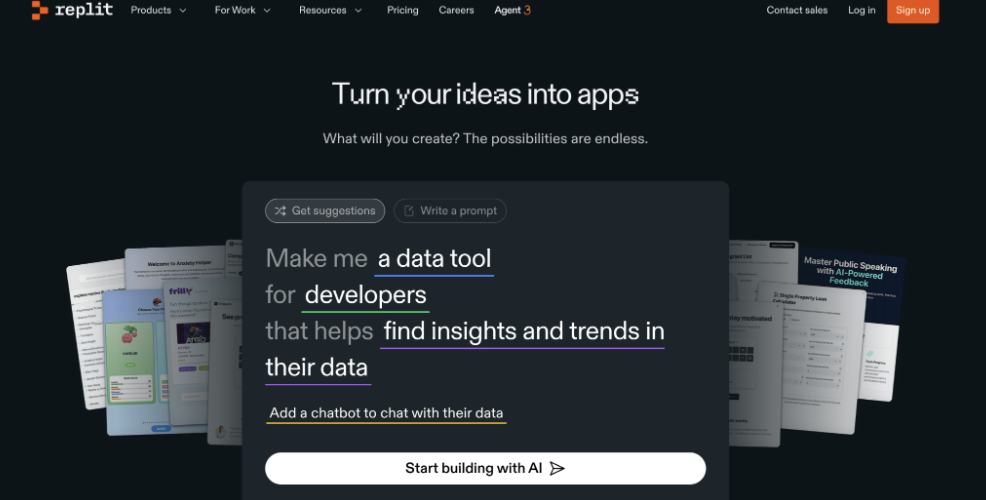
Replit is a cloud IDE that supports 50+ languages. Its AI assistant, Ghostwriter, accelerates code generation, refactoring, and test‑writing. While it isn’t purely “chat‑to‑app” in the sense of non‑coders building everything from prompts, its strength lies in enabling developers to build anything faster.
Target Audience: Developer teams, full‑stack engineers, educational settings, tech founders comfortable coding but want AI assistance.
Key Features: Cloud IDE accessible everywhere, AI code suggestions and completions, multi‑language support, integrated hosting and projects, and collaboration features.
Pitfalls: Not ideal for non‑coders; while fast, it still requires programming knowledge; pricing/compute costs can escalate for heavy projects.
Pricing: Free Starter plan; paid plans from ~$10‑20/month (e.g., Core plan) and Teams plans ~$35/user/month.
v0.dev (by Vercel)
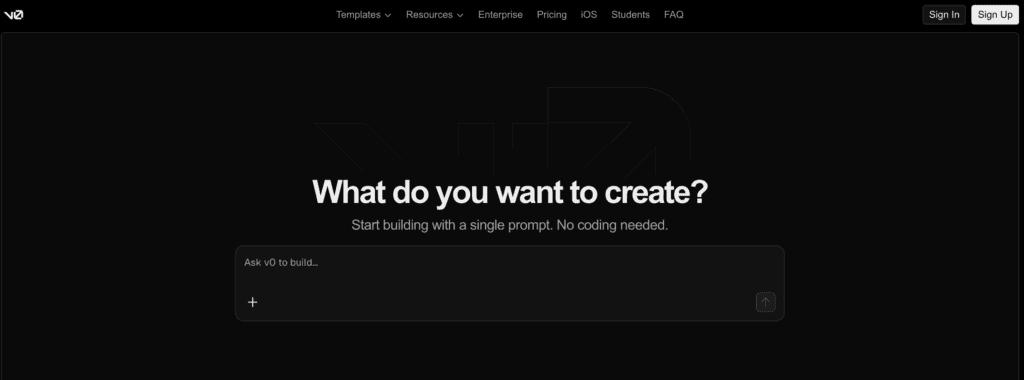
v0.dev is Vercel’s text‑to‑UI builder – you type a prompt and instantly get functional React components styled with Tailwind CSS. It’s designed for frontend developers who want to skip the tedious part of UI scaffolding. Generated components integrate seamlessly into Next.js projects and deploy directly to Vercel.
Target Audience: Frontend developers, designers, and prototypers.
Key Features: Text‑to‑UI generation, Next.js integration, instant Vercel deploy, and clean code output.
Pitfalls: Frontend‑only – no backend or database logic; limited to the React ecosystem.
Pricing: Free tier with Pro/Team upgrades.
Debuild

Debuild focuses on hyper‑fast web‑app generation. Users describe what they need – “dashboard with login and charts” – and within minutes, Debuild scaffolds a full app using React and Node.js. It’s one of the earliest chat‑to‑app experiments that prioritized visible code and instant deployment.
Target Audience: Indie hackers, makers, and early‑stage founders needing quick demos.
Key Features: Text‑prompt app creation, React + Node.js stack, auto‑UI generation.
Pitfalls: Limited scalability and customization options; inconsistent backend logic.
Pricing: Freemium with limited monthly generations.
Cursor

Cursor is an AI‑native code editor that embeds multiple agents directly into the dev workflow. It’s designed for engineers who want conversational AI inside their editor – not as a separate chatbot. You can discuss architecture, refactor code, or auto‑generate tests collaboratively with AI.
Target Audience: Developers integrating AI deeply into daily coding.
Key Features: Multi‑agent assistance, inline code editing, context memory across files, and local execution.
Pitfalls: Not for non‑technical users; still IDE‑based, with a learning curve.
Pricing: Freemium; Pro plan ≈ $20 / month.
Dust.tt

Dust.tt blurs the line between chatbots and app builders, letting users orchestrate AI workflows and APIs in one interface. It’s especially strong for internal tools and AI‑driven automation. While not a traditional CRUD app generator, it builds functional web interfaces connected to AI agents.
Target Audience: Technical founders building AI‑product backends or integrations.
Key Features: AI workflow orchestration, multi‑agent chains, custom API connectors, shareable dashboards.
Pitfalls: Requires technical setup; limited UI flexibility.
Pricing: Usage‑based, depending on AI calls and workflow executions.
Pythagora

Pythagora is an open‑source backend generator that listens to API requests and automatically produces routes, models, and tests. Think of it as “AI‑powered Postman → backend.” It’s developer‑oriented and fits teams seeking transparency and version control.
Target Audience: Engineers and backend developers valuing open‑source autonomy.
Key Features: Auto backend scaffolding from traffic/API calls, test generation, and Dockerization.
Pitfalls: Backend‑only; still experimental in complex schema generation.
Pricing: Free, open‑source.
Conclusion
The 2025 wave of AI chat‑to‑app builders is no longer about novelty – it’s about maturity.
We’ve entered an era where founders, designers, and engineers can talk to their computers and watch production‑ready systems emerge. But not all platforms are created equal. Some trade scalability for speed, others transparency for convenience, and a few – like AppWizzy – finally strike a balance between AI‑driven creativity and long‑term engineering discipline.
The right choice depends on your stage and intent:
- If you’re validating an idea and need fast visual feedback – Lovable or Debuild can get you there overnight.
- If you’re an engineer wanting to stay in control while leveraging AI’s muscle – Bolt.new, Cursor, or Replit are your playgrounds.
- If you’re chasing design velocity – v0.dev is unmatched.
- If your product relies on AI workflows or data intelligence – Dust.tt, Pythagora expands what “building an app” even means.
- And if you’re ready to build something real, meant to live, scale, and raise capital on – AppWizzy (by Flatlogic) is the platform to bet on.
Because at the end of the day, speed is only useful when the foundation lasts.
Choosing the right AI builder isn’t about who generates code faster – it’s about who generates value that survives your next funding round, your next security audit, and your first thousand users.
If you’re building for longevity – not just a demo – start with a platform that thinks like an engineer.
Comments